Table of contents:
Key takeaways:
- You can make YouTube Shorts directly in the YouTube app. Record or upload your own video, edit it, and then you can publish.
- For now you can only upload Shorts on the desktop site. You’ll need to use an external editor for editing and creation.
- When creating Shorts, think about your audience and goals, and make sure to hook your audience with visuals and a good caption.
What’s a quick and efficient way to grow your audience on YouTube?
The obvious answer in 2024 is short-form videos.
Short-form videos have exploded in popularity, and it makes sense. They’re fun for viewers and easy for content creators.
Shorts is YouTube’s answer to this growing trend.
If you want to make YouTube Shorts but aren’t sure how to do it, consider this your step-by-step guide.
What are YouTube Shorts?
Shorts is YouTube’s short-form video section within the platform. It’s YouTube’s version of Instagram Stories or TikToks.
Initially released back in September 2020, it's the place to share and binge bite-sized videos, lasting no more than a minute.
Viewers can find and watch Shorts from YouTube’s homepage or in the Shorts tab when using the YouTube app.
YouTube Shorts requirements
Here are some basic requirements to keep in mind before starting on your Shorts journey.
- Video length: Shorts videos must be 60 seconds or less in length.
- Orientation and aspect ratio: Make sure your video is in a vertical orientation with a 9:16 aspect ratio and 1920 by 1080p resolution. YouTube Shorts can also be square with a 1:1 aspect ratio and 1080 by 1080p resolution.
- Age requirement: Creators must be at least 13 years old to post a video. But there’s a caveat; if you’re 13 to 19 years old, you need parental or guardian consent to set up an AdSense account.
How to create YouTube Shorts in the app: Step-by-Step
Here’s how to create a short in the YouTube app:
Step 1: Download and log in into the YouTube mobile app
If you haven’t already, download the YouTube app on your phone.
You can find it in the Google Play store on Android and in the Apple Store on iOS.
Open the app and log in to your account.
Step 2: Create a new Shorts post
Click the “+” button on the bottom of your home screen.
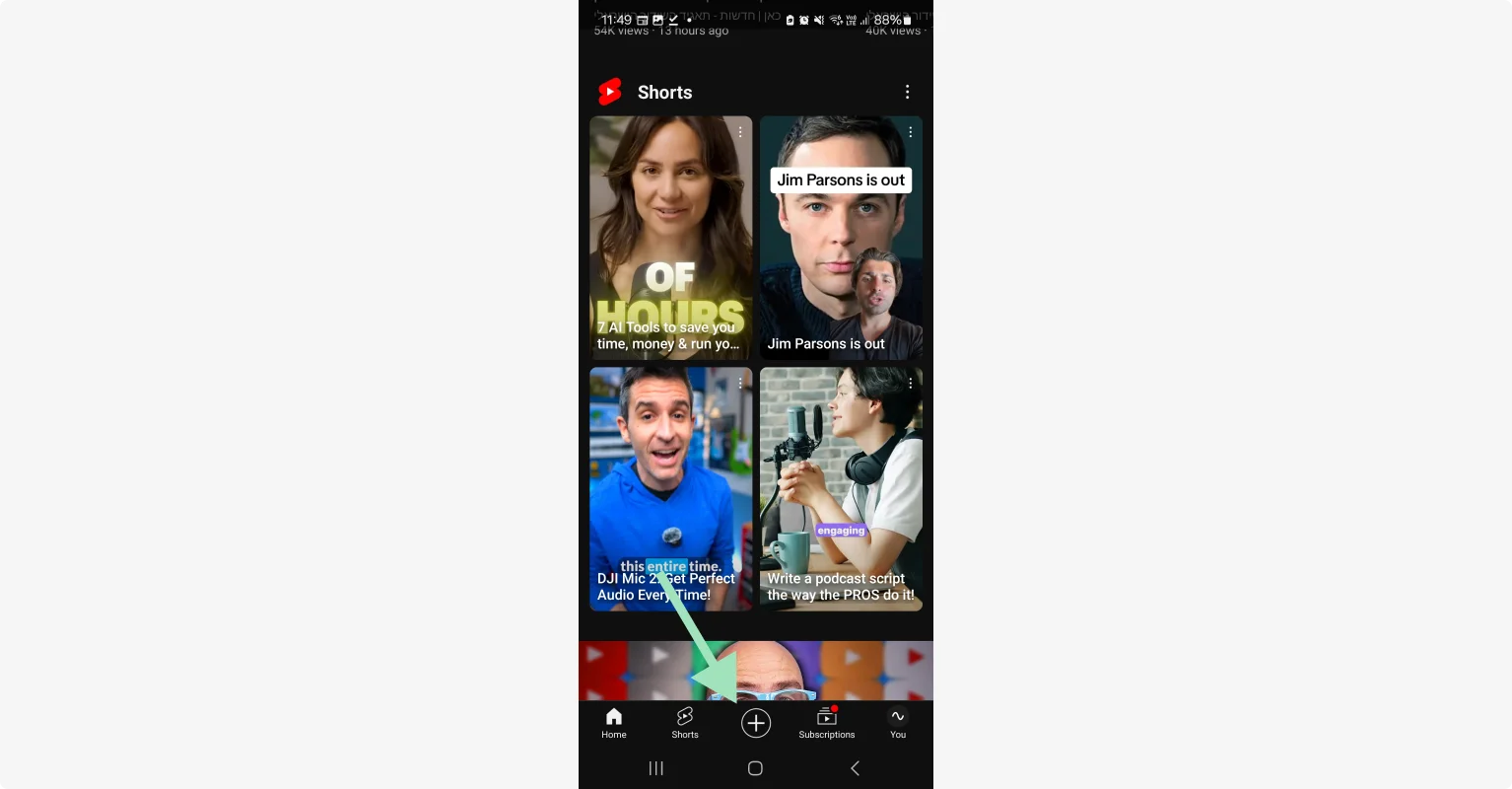
Make sure you’re in the “Short” tab. If not, scroll the bottom carousel left or right to get there.
Step 2: Record or use existing video content
Recording a Short
Hit the large red record button to create a new video for your Short.

You can use filters and effects from the left toolbar to customize your look.
Hit the downwards arrow for more effects such as “Retouch,” “Lighting,” and “Align.”
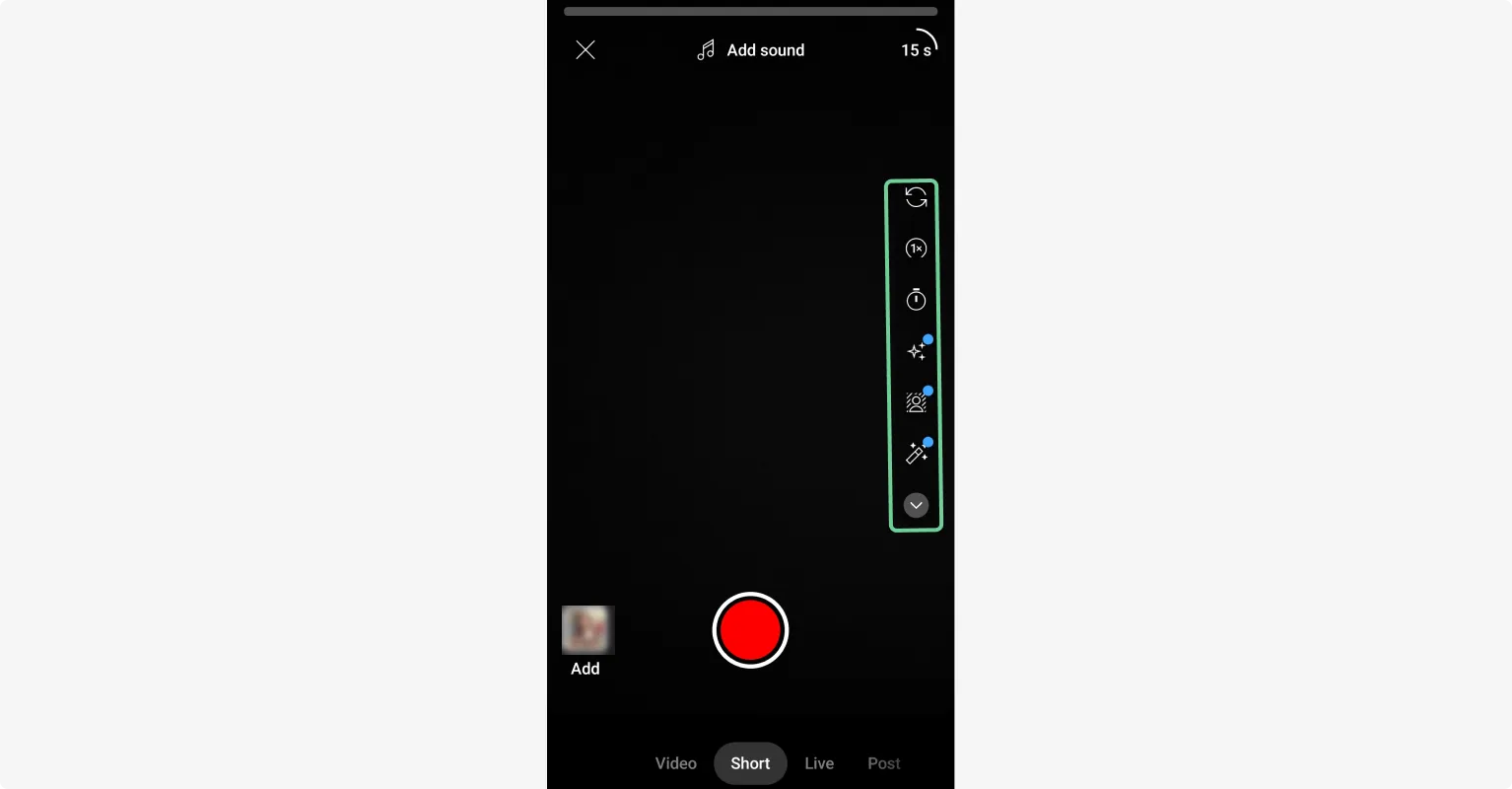
There’s even an option to apply a green screen to add a virtual background. Click the icon of a person with a lined background to do this.
Uploading videos for a Short
If you have your own videos you want to upload then:
Hit “Add”, and this will open up your media library in the bottom-hand corner of the screen.
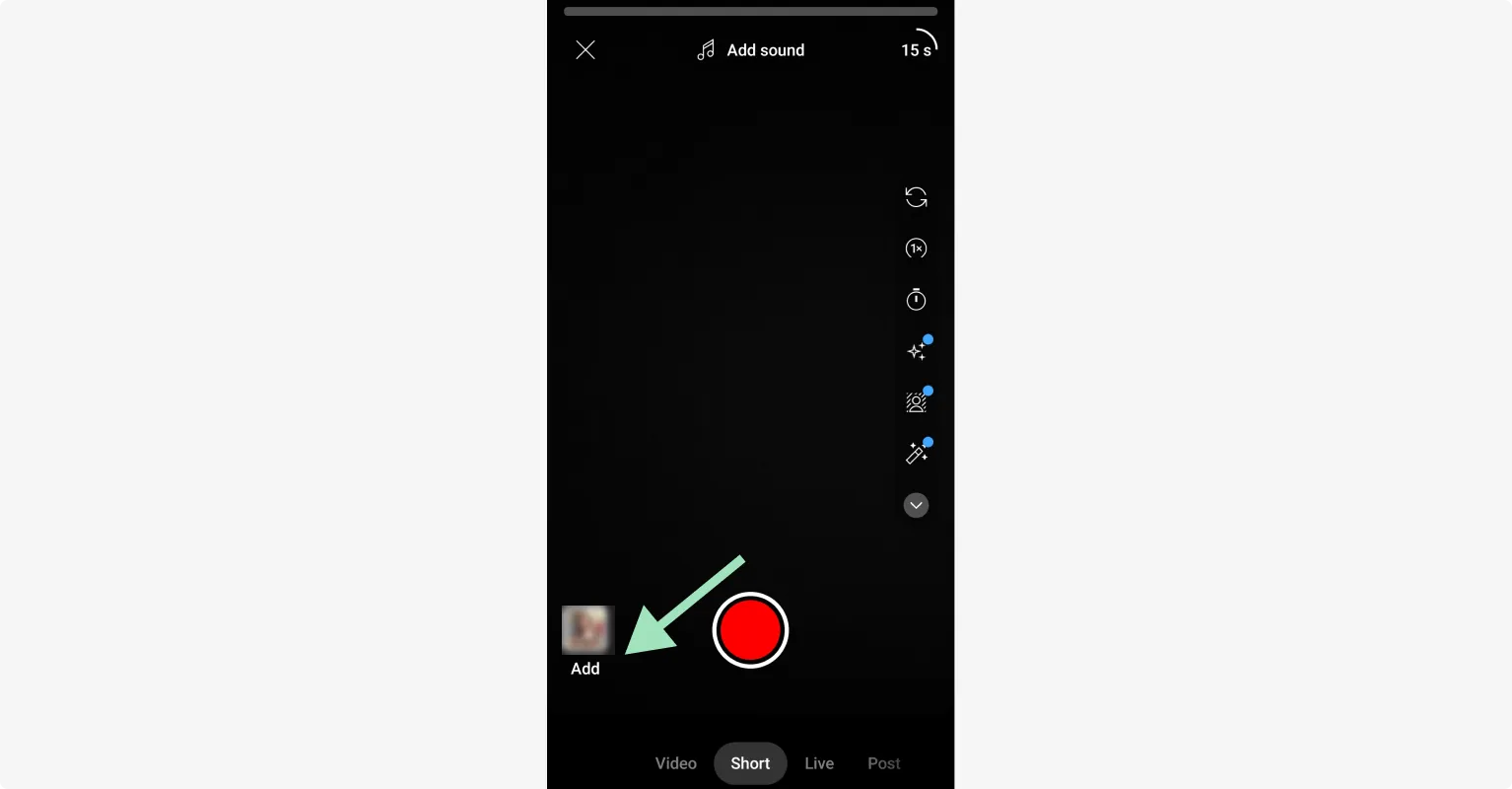
Select an existing video from your library.
You may have to grant YouTube access to photos and videos on your device.
Step 3: Trim your Shorts video (and add extra clips)
You can choose the length of your video on the top right. Click the “15 s” button and adjust to the length you want.
Remember, your video has to be shorter than 60 seconds.

You can trim your recording or video to fit this requirement. Or, if you want to add multiple clips, then you can trim your video to choose how long each clip is.
Simply drag the beginning or end edges of your recording timeline to trim your video.
Once you’re happy, hit “Done.”
You’ll go back to the recording page.
If you want to add more clips, repeat the process above.
Step 4: Edit your YouTube Shorts
After you’ve got your final roll of video, click the tick on the bottom right to go to the editor.
In the Editor, you’ll see a toolbar on your right for filters, effects, and text. You can also click the “Timeline” button to view the recording timeline.
.webp)
Here are a few editing basics for making a YouTube Short:
How to add music to your Short:
Hit “Add sound” to browse YouTube’s library of music.
To save a track, hit the bookmark icon to the right of the screen. These tracks will show up in “Saved.”
.webp)
Click on a song to preview it. A blue arrow will appear on the right of the track. Click this to add the track to your video.
How to add text to your Short
Back in the video preview hit the “Aa” button from the right toolbar.
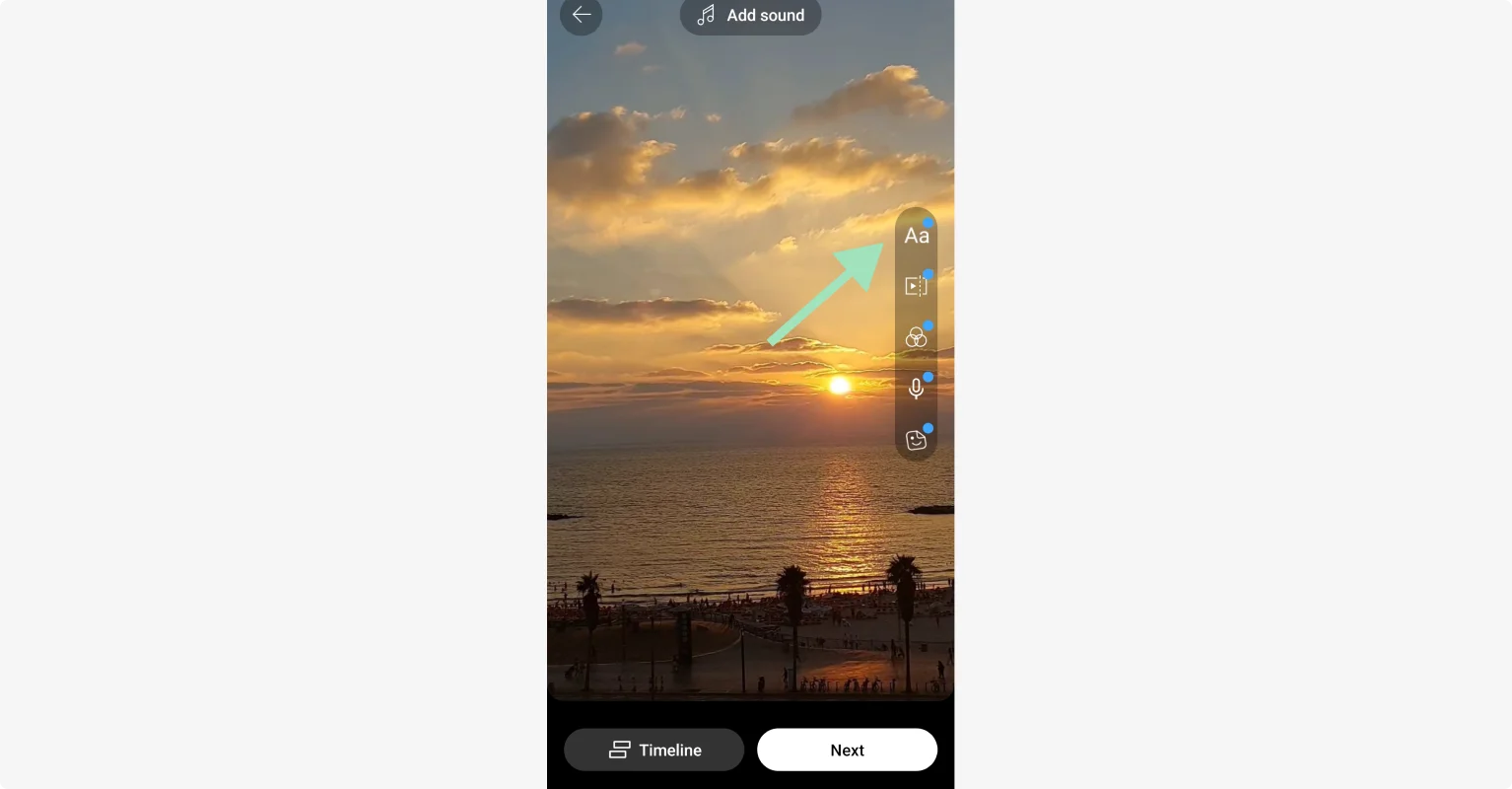
Type your text in. Select a color and click on the top font bar to choose a font.
You can also use the alignment button to align your text (bottom left). And, use the slider on the left to increase or decrease the size of your text.
.webp)
Want to turn your text into speech? Click the button that looks like a person speaking on the top left. Select a voice and voila.
How to customize your Short
Feeling creative? Hit the filter icon from the toolbar.
Here you can choose from a variety of filters. Select one and then click the tick button to apply it.
You can also click the Sticker button to add a Q&A or an “Add yours” prompt.
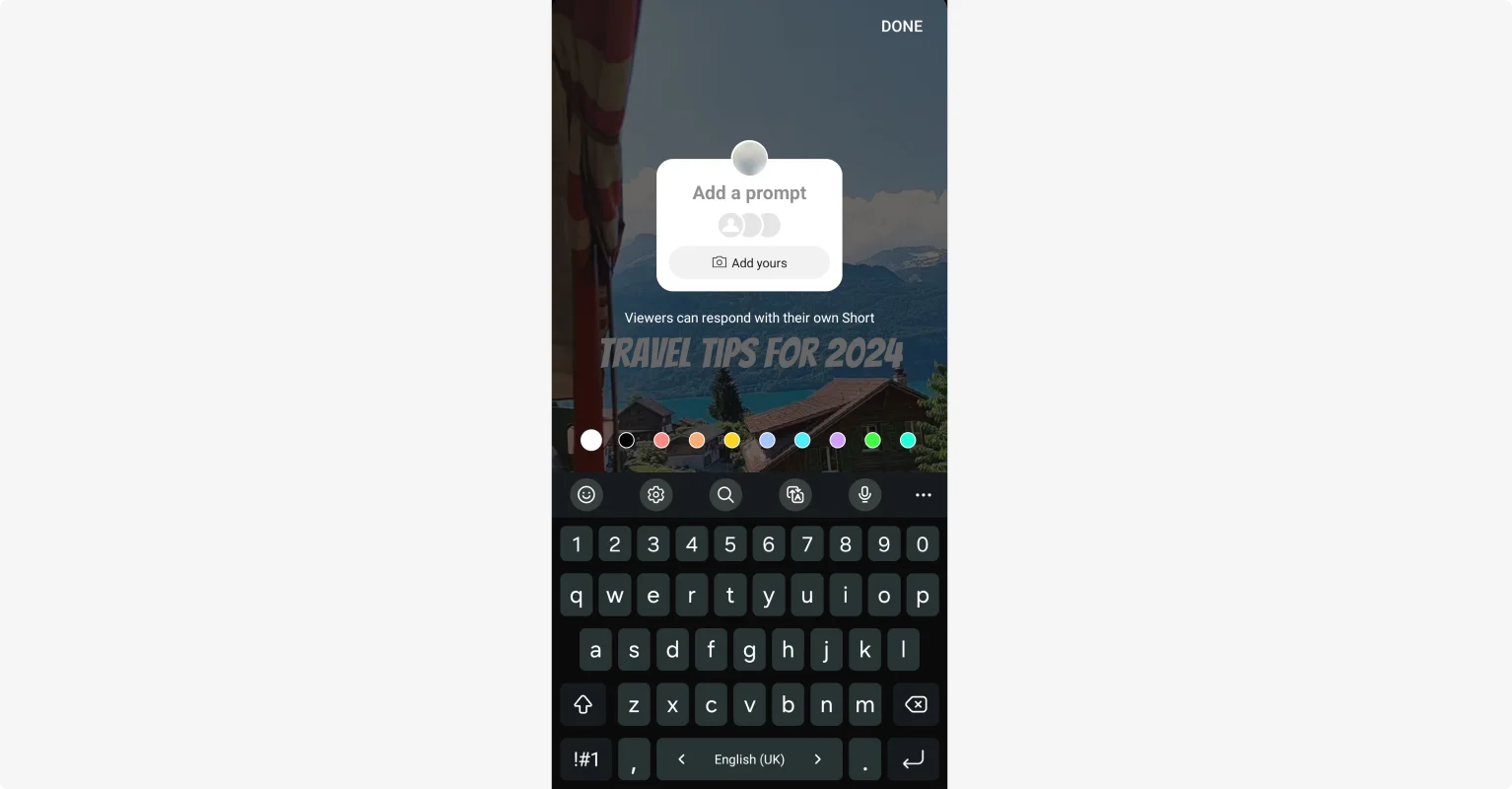
Once you’re happy, click “Next”.
Step 5: Publish your YouTube Short
You’ll go to a screen to add more details.
- Give a caption to your Short.
- Choose whether to post it as Public,” “Unlisted,” or “Private.”
- Decide whether to post it immediately or schedule it.
- Add a location for your Shorts if that’s necessary for you.
In “Select audience,” you can decide whether to choose “Yes, it’s Made for Kids” or “No, it’s not Made for Kids.” You can also decide whether you want to restrict your video to viewers over 18 years of age.
Other options include linking a related video of yours, adding a paid promotion label, saying whether it's altered content, and switching comments on or off.
When you’re ready to share your Short with the world, hit “Upload Short.”
How to make YouTube Shorts on a PC
You can’t record and edit YouTube shorts directly on the desktop site. But you can upload your own Shorts.
To upload a Short, you’ll need to use a third-party video editing software.
For example, here’s how to create a YouTube Short on PC using Riverside.
Step 1: Record or upload your video clips in your editor
With our above example, log in to your Riverside account, or sign up for one.
Choose a studio from the right menubar. If you don’t have any you can click the “+” button to create a new one. (Learn more here).
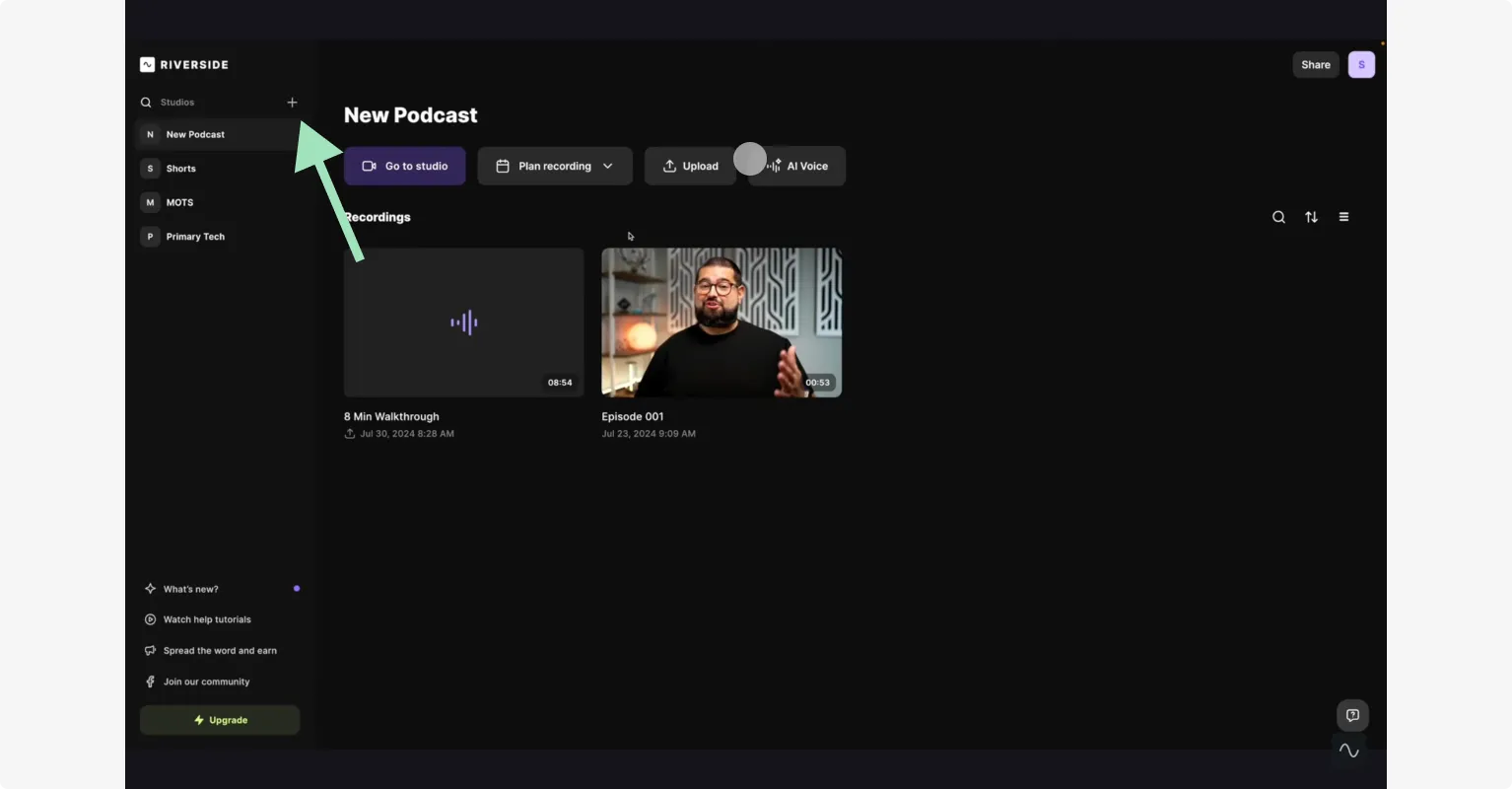
In your studio, you can click:
- “Record” to start a new recording. (Learn more on recording here).
- “Upload” to add your own videos.
- “Edit” to use an existing recording for your Short.
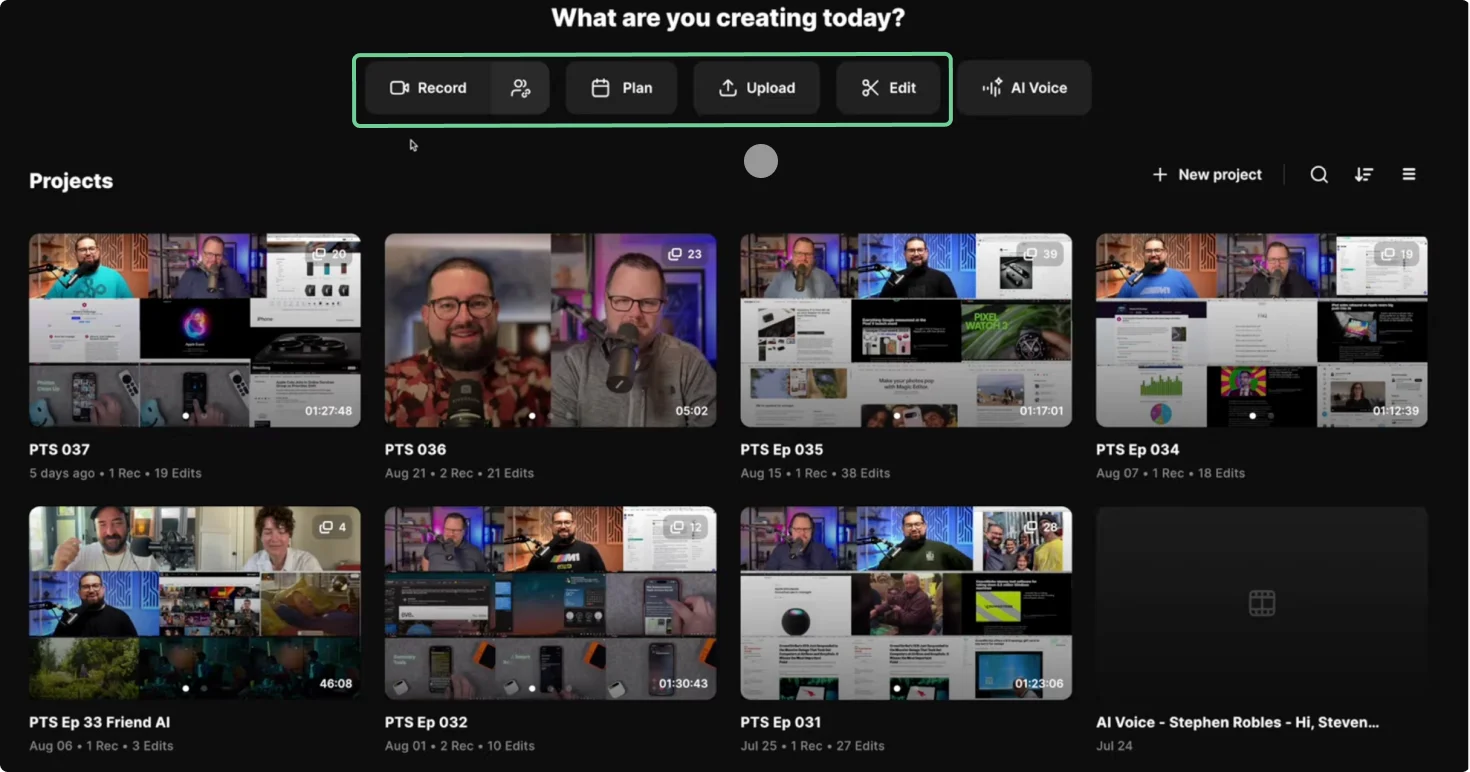
Step 2: Edit your YouTube short
Once you’ve got your recording, you can get editing.
Creating clips (optional)
Skip this step if you’ve got a short-form video ready for editing.
But, if you’ve got a long-form recording (for example, a full YouTube video), then here’s an easy way to turn it into multiple Shorts.
Our Magic Clips tool takes your recording’s key moments and turns them into short, shareable videos.
To use this, navigate to the video you want to edit. Click “Generate Magic Clips”. Then we’ll do the rest.
.webp)
Once Riverside has generated your clips, click on each one to view them.
You can also click “Edit” to go to the editor and adjust them.
Set the right layout
If you haven’t already click on the recording you want to use and click “Edit” to go to the Editor.
First, make sure the dimensions are set to 9:16 in the top right of the screen. This matches YouTube’s Shorts requirements.
.webp)
Trim your YouTube recording
Trim your video so it’s within the 60-second time limit.
With the text-based editor, you can do this by simply deleting text in your recording transcript. The editor will remove the matching video from your recording.
Alternatively, you can use the timeline and drag the edges to shorten your recording. You can also place the timeline at a specific point and click “Split” to create cuts. This will let you cut out sections in the middle of your recording.

Adjust your audio and add music
With Riverside, you can touch up your audio in a few quick clicks.
Select the “AI Producer” from the right toolbar. You’ll have the option to remove long silences, and filler words and completely touch up your audio.
.webp)
If you want to add music or voiceover click the “Music” button from the right toolbar. You can select a track or upload your own.
Customize your YouTube Short
All that’s left to do is to style your video.
Click:
- “Brand” to add your logos and customizable backgrounds.
- “Captions” to add dynamic captions which you can style as you like.
- “Text” or “Images” to add overlays.
Step 3: Exporting in Riverside
Once you’re happy, hit “Export.”
Choose your video quality (720, 1080px etc). You can also remove Riverside’s watermark, normalize audio levels, and remove background noise.
After adjusting export settings, click “Export video”.
.webp)
Then click “Go to exports” to view your video.
You’ll get directed to your studio dashboard. Scroll down to see your video exporting. Once it’s ready click on the “Download” button to save it on your PC.
Step 4: Upload your YouTube Shorts
Sign in to your YouTube account.
Click “Create” in the top right and then “Upload Video.”
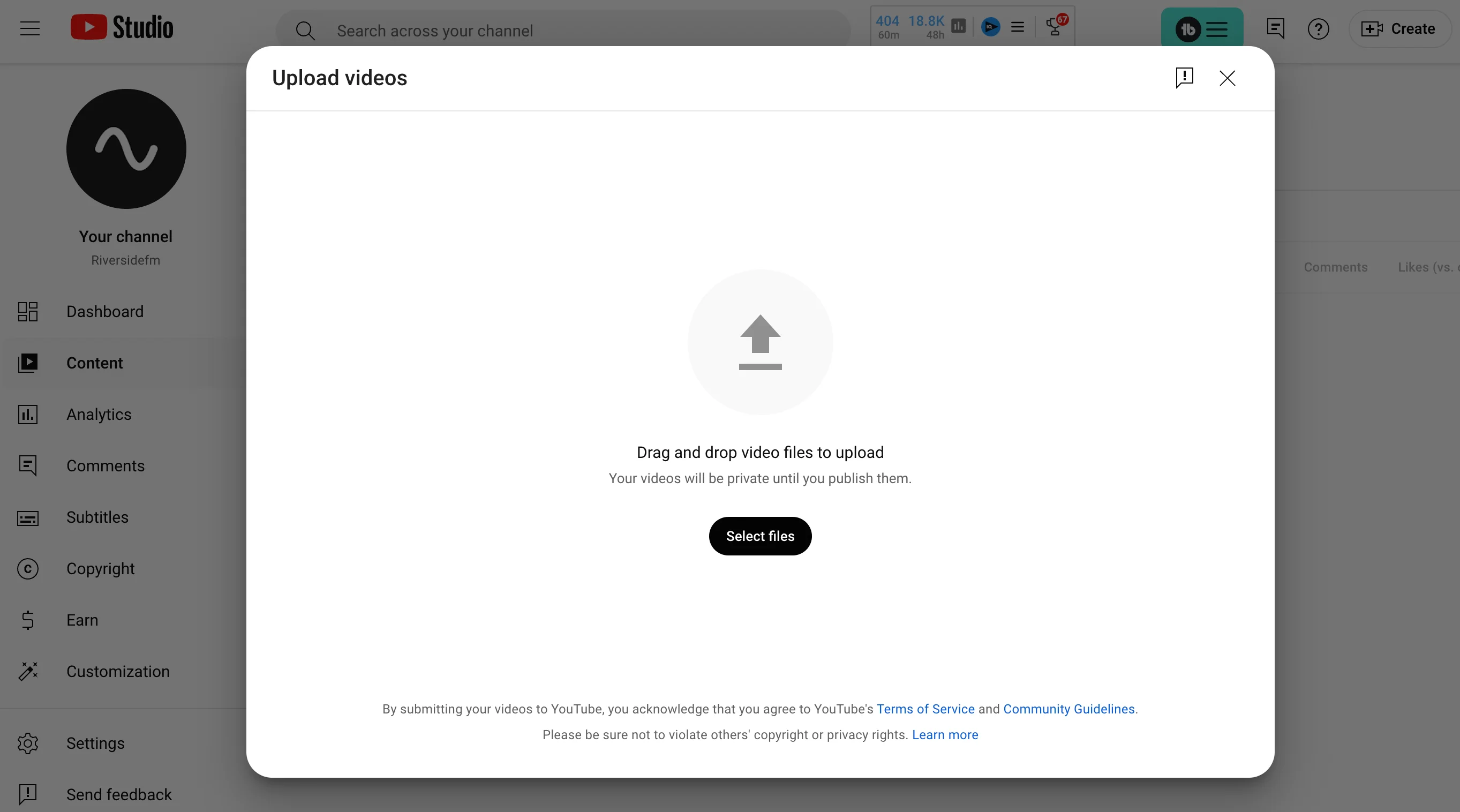
Select the file that you just created in Riverside.
Fill in your Shorts details:
- Give your Short a title and a description.
- Choose a thumbnail and add your Short to a playlist (optional).
- Select your audience and age restriction.
- Add video elements to your Short such as an end screen (optional).
- Set the Short’s visibility as “Private,” “Unlisted,” or “Public.”
- Either schedule your Short or publish it immediately.
Note: Ensure that the your video link says /shorts/ as this means it has been recognized as a Short. This makes sure it’ll appear in the “Shorts” tab rather than “Videos.”
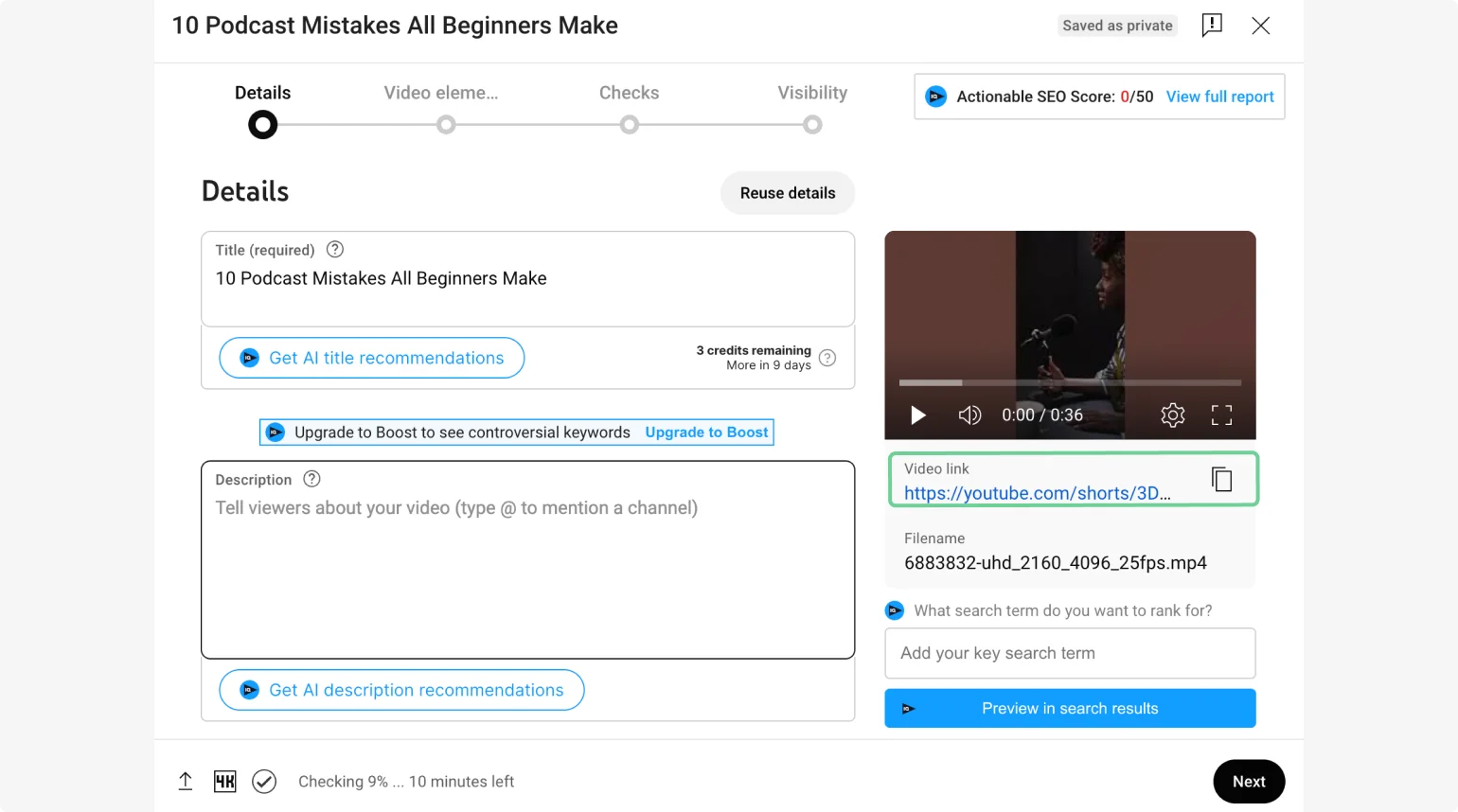
When it’s processing it may first appear in “Videos,” but if successfully recognized will be moved to the “Shorts” tab and appear in the Shorts feed.
Why should you create YouTube Shorts?
Let’s take a look at the associated benefits of incorporating Shorts into your ongoing YouTube strategy:
- Exploding in popularity: YouTube Shorts reached more than 70 billion daily views, as of October 2023.
- Device usage flexibility: Shorts can be viewed on all major devices. All viewers need is an internet connection.
- Competitive advantage: You have a competitive advantage, as not every YouTuber fully uses the Shorts feature (even though it's been around since 2020).
- Google prioritizes YouTube content: Google gives preferential display opportunities in search results, as they own YouTube and want to see the proliferation of this feature.
- Access to new audiences: Shorts are shown in all of YouTube’s search results, and various YouTubers have reported a positive impact on overall channel performance since posting Shorts. This is backed up by research showing that Shorts tend to attract more views and likes, and the platform is pushing users to watch them.
- Easy to create: Short-form videos are easier and quicker to create compared with longer form.
Tips for creating YouTube Shorts
Think about your end goal:
Every Short you create and share needs to have an end goal or purpose. What do you want people to do after watching?
Focus on your audience:
What YouTube content will resonate with them? How can you capture their attention? Brainstorm some YouTube Shorts ideas before you start filming.
Get to the point:
Get to the point quickly - 60 seconds isn’t a lot of time.
The thumbnail and caption matter:
Getting these two elements is crucial in getting views, as it’s how you entice people to watch your content. Captions can also include keywords that will help your videos appear in Google search. (If you're using Riverside, we'll automatically generate optimized captions for you with our automated descriptions.)
Be experimental:
Experiment with your Shorts to see what resonates with your audience and gains attention. This applies to how you promote your Shorts as well!
Consistency is key:
Post Shorts consistently and regularly, as this is what matters to the YouTube Shorts algorithm. Expert influencers recommend posting at least once per week and as often as 2 to 3 times per day.

Post when your audience is online:
Run experiments and find what days and times are best for your audience and gain the most views.
Analyze the data:
Keep your eye on data and insights. If only 25 seconds of a 60-second Short is being viewed, edit it down to this time.
Final thoughts
Incorporating Shorts into your strategy is essential if you’re looking to grow your reach and audience on YouTube. Compared with traditional longer-form YouTube videos, Shorts are considerably easier and quicker to create - and they tend to get more engagement!
Don’t overthink the content you’re creating. Make sure it’s fun or engaging for the intended audience, and just get posting content and experimenting with different video ideas. Learn what works well, and take it from there!
If you’re looking for a simple option to make the highest-quality YouTube Shorts, try Riverside. It’s a simple video editor that can help you take your content to the next level. It can even automatically cut down longer-form videos into short, shareable video clips for YouTube Shorts.
FAQs on How to Make YouTube Shorts
Why is my Short being shown as a YouTube Video?
Did you upload a YouTube Short only to realize it is being shown as a traditional longer-form video on YouTube?
This is a common problem, and it usually happens when your video doesn’t meet the requirements for a Short.
Shorts must be no more than 60 seconds in length and videos must be vertical with the correct 9:16 aspect ratio.
How long can a YouTube Short video be?
Shorts can be up to 60 seconds long. The idea of Shorts is that they are bite-sized videos that are quick and easy to consume, similar to videos on TikTok or Instagram Stories. There is no ideal length for Shorts, as it all depends on your audience. Experiment with Shorts that are 15 seconds, and compare them with 30 seconds, and 60 seconds.
Note that if you’re using music from YouTube’s library or original sound from another video, the maximum length is limited to 15 seconds due to licensing restrictions.
Learn in our full guide on how long YouTube shorts can be.
How can I track the performance of my YouTube Shorts?
You can track the performance of Shorts on both your desktop and mobile. On desktop, head on over to “Content” when you’re logged in, hover over the Short you wish to analyze, and click “Analytics.”
On mobile navigate download the “YouTube Studio” app, and once logged in tap on “Analytics,” which appears at the bottom of the screen.
How to make money on YouTube shorts??
If you want to monetize your YouTube Shorts, you can join YouTube’s Partnership Program to start making money through Shorts advertising opportunities. To join, you need to have 1,000 subscribers and 10 million public Shorts views in the last 90 days.
Should I use hashtags for my Short?
Yes, you should use relevant hashtags for your Short, as this helps with categorization, making it easier for viewers to find your content. Hashtags also help your Short reach a larger audience, by increasing the chances of appearing in search results for those keywords. Hashtags can be added to both captions and descriptions.















---Riverside.webp)
.webp)


